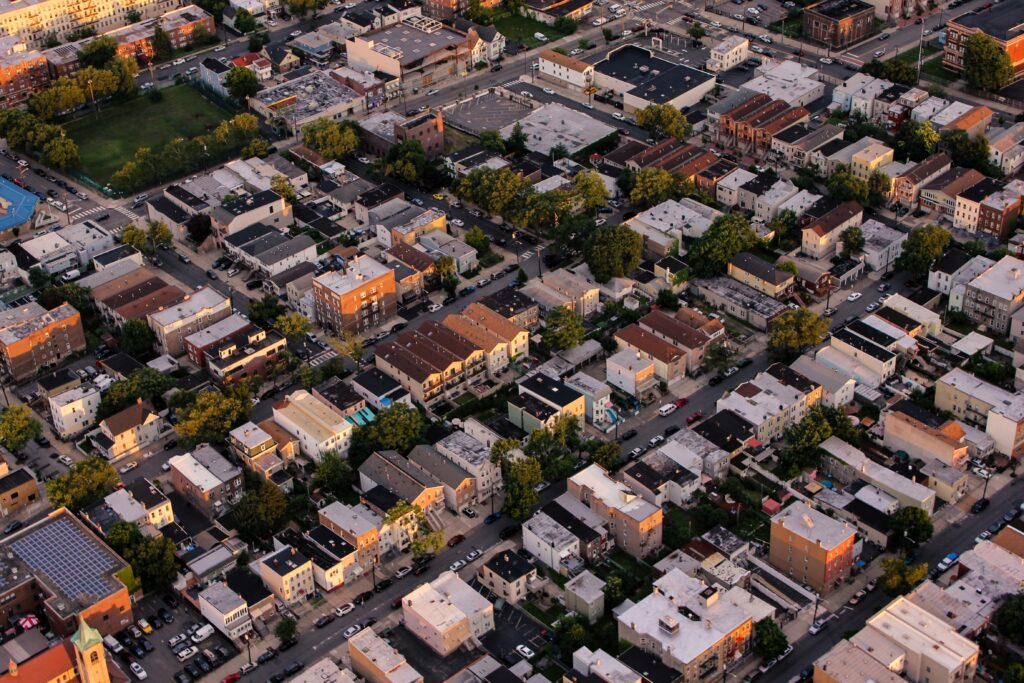Family, Government, Health, Resources
NYC’s first-of-its-kind report on Asian New Yorkers shows surprising results
Despite being among NYC’s fastest-growing populations, Asian New Yorkers remain understudied and misrepresented. As such NYC sought to disaggregate its Asian population in its report on the health of Asians and Pacific Islanders, which published in 2021. At the time of the report, NYC was home to 1.2 million Asians who make up 14% of the city’s 8.5 million people. The report highlights differences in demographic and social economic characteristics, health behaviors, and health status of Asians by ethnicity. Some surprising findings for NYC include: 1 in 2 Asian New Yorkers is Chinese, more than half of Asian Indians over the age of 25 do not have a college degree, and Koreans face an alarmingly high suicide rate.
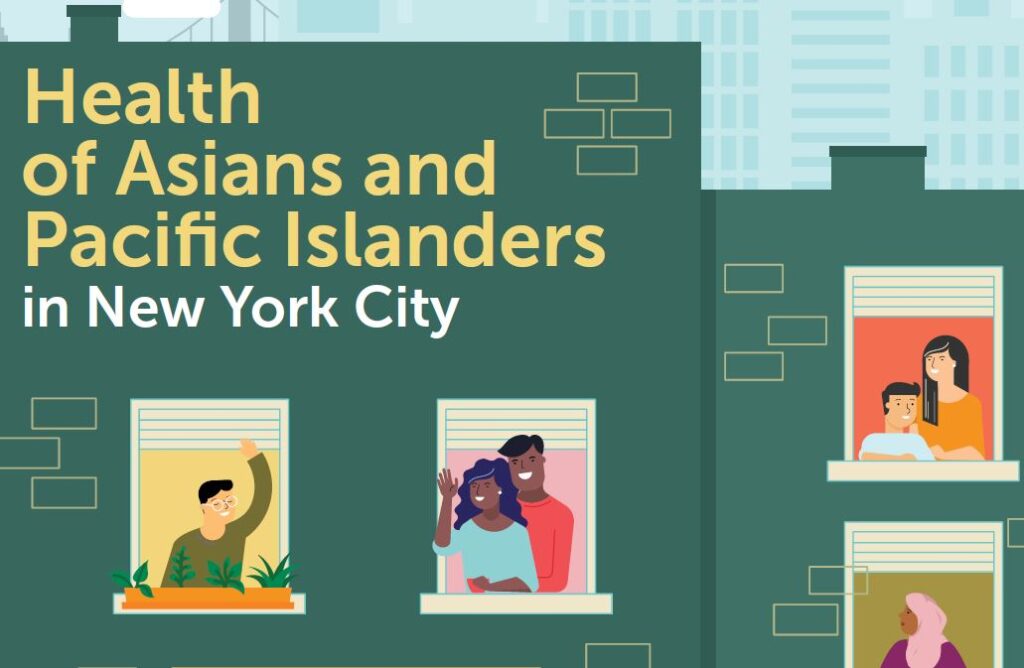
Note: Some numbers in the NYC’s API health report may be dated; however, the data highlights remain relevant. The latest U.S. Census data shows that the Asian population in NYC has increased to 1.4 million and represents 16% of NYC’s 8.8 million people.
Despite being among NYC’s fastest-growing populations, Asian New Yorkers remain understudied and misrepresented. As such NYC sought to disaggregate its Asian population in its report on the health of Asians and Pacific Islanders, which published in 2021. At the time of the report, NYC was home to 1.2 million Asians who make up 14% of the city’s 8.5 million people (around 4,400 Pacific Islanders called NYC their home).
Asian New Yorkers are diverse. NYC’s report highlight differences in demographic and social economic characteristics, health behaviors, and health status of Asians by ethnicity. The report shows surprising results that would have been masked by lumping all Asians into a single group. Some key findings are as follows:
Nearly 1 in 2 Asian New Yorkers is Chinese
Of the 1.2 million Asian New Yorkers, 31% are U.S. born and 69% are foreign-born with a majority having been in the U.S. for 10 or more years. At 48%, Chinese New Yorkers are the largest ancestry group representing nearly 1 in 2 Asian New Yorkers (as compared to 1 in 5 of Asians nationally).
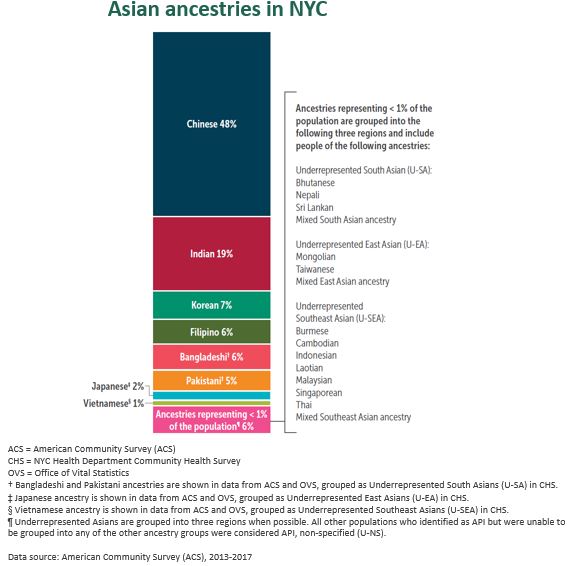
More than half of Chinese and Bangladeshi New Yorkers do not speak English very well
Asian and Pacific Islander New Yorkers (46%) are 2 times more likely to have limited English proficiency than overall NYC (23%), and higher than 1 in 3 Asians nationally (30%) who have limited English proficiency. When disaggregated by ethnicity, 61% of Chinese and 56% of Bangladeshis in NYC have limited English proficiency.
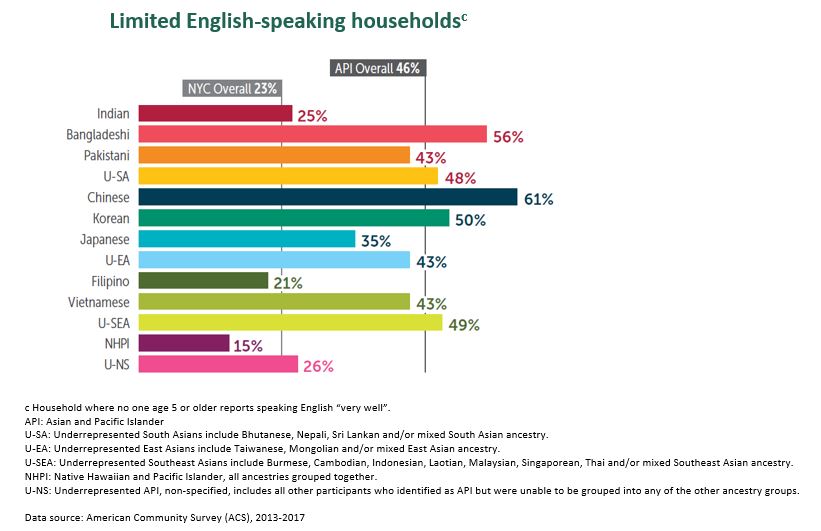
More than half of Bangladeshi and Pakistani households live below 200% of the federal poverty level
Asian New Yorkers are more likely to live in poverty – 40% of APIs in NYC have incomes below 200% of the federal poverty level compared to the 10% poverty rate for Asian nationally. By ethnicity, 58% of Bangladeshi, 55% Pakistani, and 45% of Chinese New Yorkers have incomes below 200% of the federal poverty level. In contrast, fewer Japanese in NYC have low incomes with 67% working in management and professional occupations.
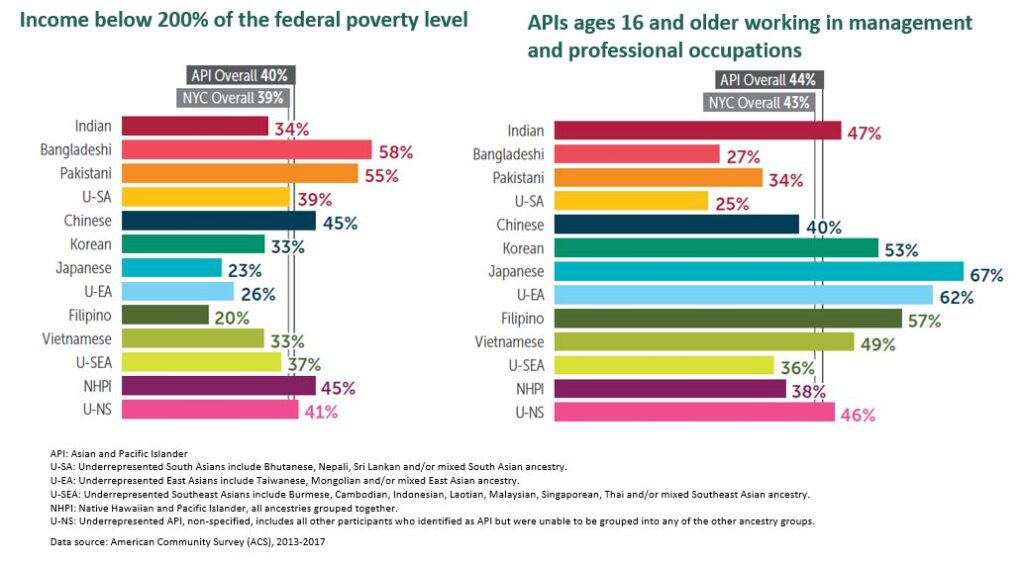
1 in 4 Asian New Yorkers over the age of 25 have less than a high school education
1 in 4 Asian New Yorkers over the age of 25 have less than a high school education, higher than that of NYC overall. A third of Chinese New Yorkers over the age of 25 have less than a high school education. Surprisingly, fewer Asian New Yorkers (41%) have a Bachelor’s degree or higher compared to 56% of Asians nationally. By ethnicity, 71% of Japanese and 61% of Filipinos adults in NYC have a Bachelor’s degree or higher while only 26% of Native Hawaiian and Pacific Islander and 33% of Chinese adults in NYC have a Bachelor’s degree or higher. Only 45% of Asian Indians over the age of 25 in NYC have a bachelor’s or higher degree compared to more than two-thirds of Asian Indians over the age of 25 nationally.
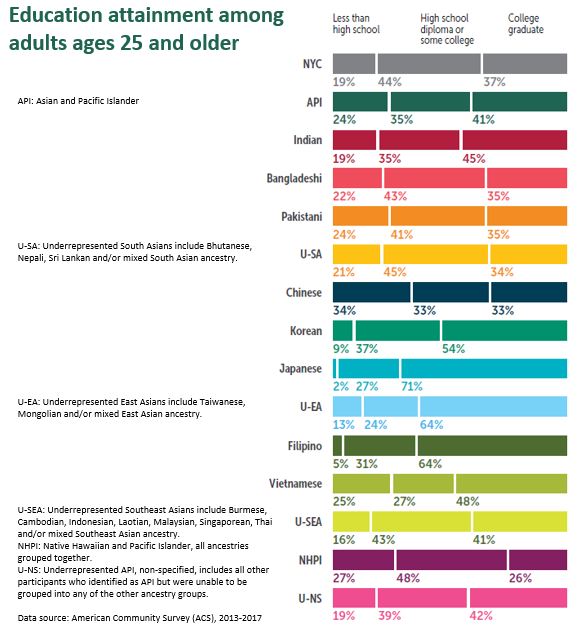
Koreans face an alarmingly high suicide rate
The suicide rate is 2.5 times higher for Koreans (13.4) than those for overall Asians (5.4) and NYC (5.4). The rate of self-reported postpartum depression among API pregnant population is higher than the overall NYC population.
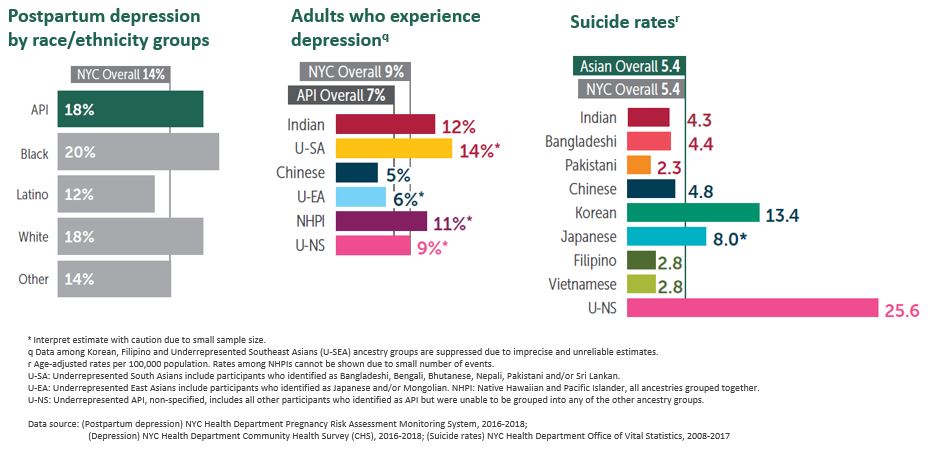
7 in 10 Bangladeshi and Pakistani households are rent burdened
More Asians (56%) in NYC are rent burdened than NYC overall (52%), where households spend more than 30% of their income on rent. Nearly 7 in 10 Bangladeshi and Pakistani households are rent burdened. And more Asians (16%) live in multigenenerational households than NYC overall (12%).
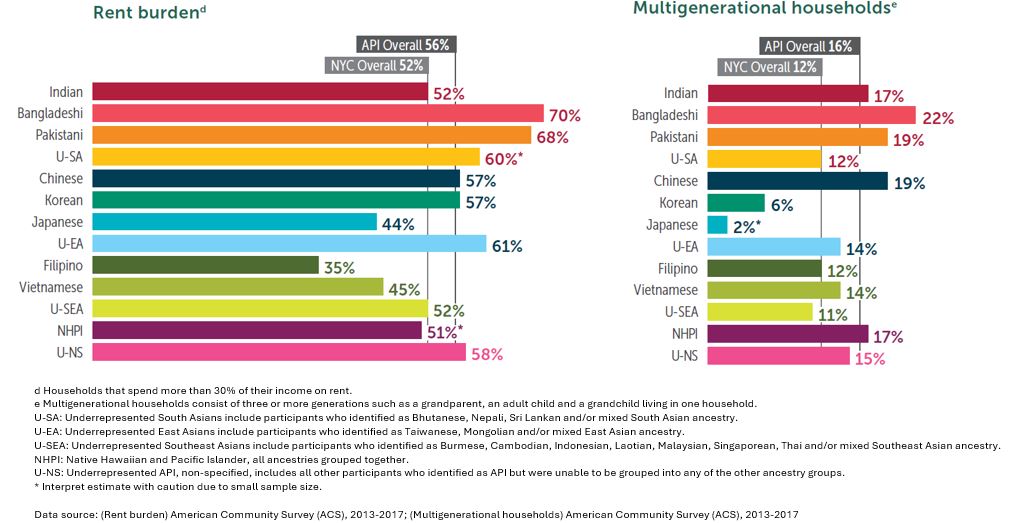
Nearly 1 in 4 Asian men smoke while 1 in 4 Koreans excessively drink
Nearly 1 in 4 or 23% of API men smoke cigarettes, a stark comparison to only 3% of API women. While the aggregate figure of API adults who drink excessively, defined as 5 or more drinks on any one occasion or consuming an average of more than 2 drinks per day for men and 4 or more drinks for any one occasion or more than 1 drink per day for women, is below overall NYC, it masks disparities by ethnicity. 24% of Koreans and 26% Underrepresented East Asians (that include Japanese and/or Mongolian) excessively drink.
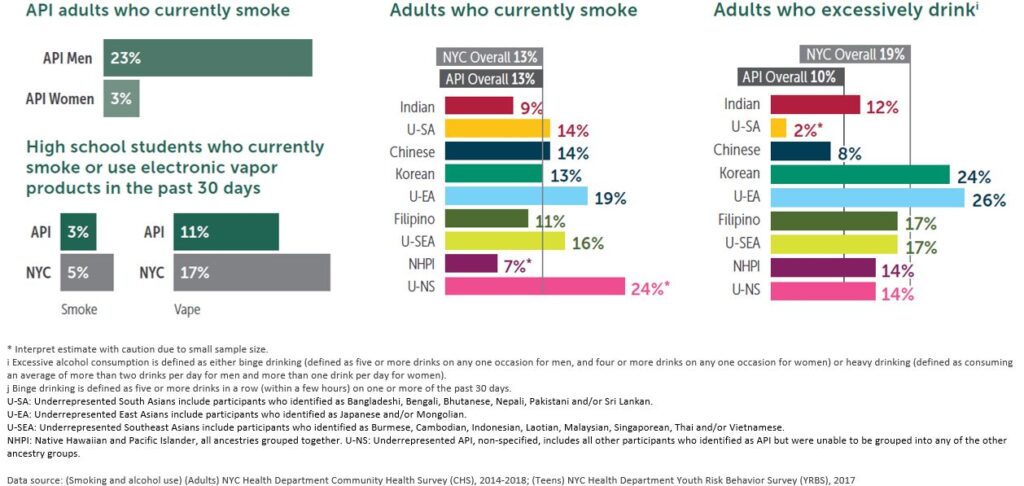
Asian Indians face higher prevalence of high blood pressure and diabetes
The prevalence of high blood pressure ranges from 15% among those of Korean ancestry to 31% among those of Indian ancestry. The American Diabetes Association (ADA), National Institutes of Health (NIH), and the Centers for Disease Control and Prevention (CDC) all recommend for Asian Americans to screen for diabetes beginning at a BMI of 23. If the BMI cutoff as lowered to 25 or higher, 36% of APIs in NYC would have obesity compared to 25% of all NYC adults. A BMI cutoff of 30 or higher show only 8% of NYC APIs adults have obesity, a drastic difference.
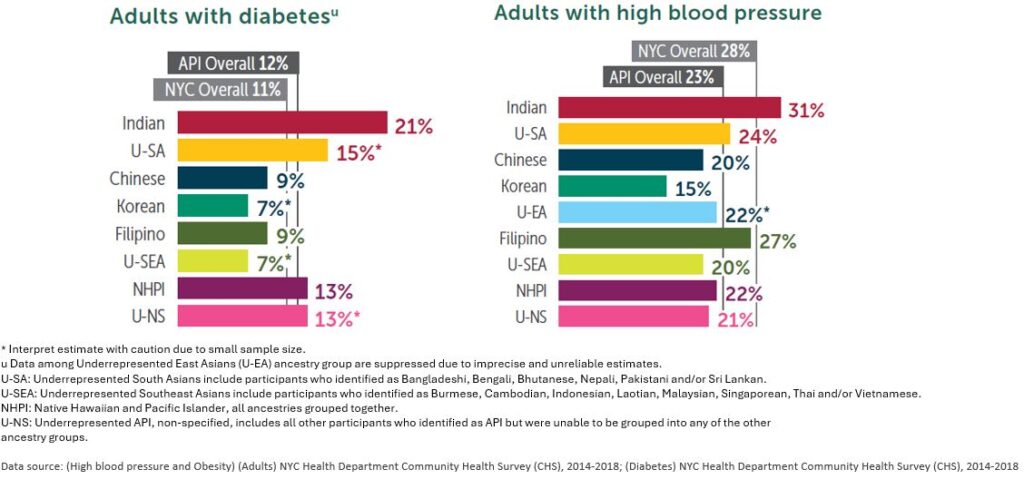
Breast cancer is the #1 cancer affecting Asian women
Despite 90% of API women in NYC having ever had a mammogram, breast cancer is the #1 cancer affecting API women. For API men, lung and bronchus cancer is the #1 cancer facing API men.
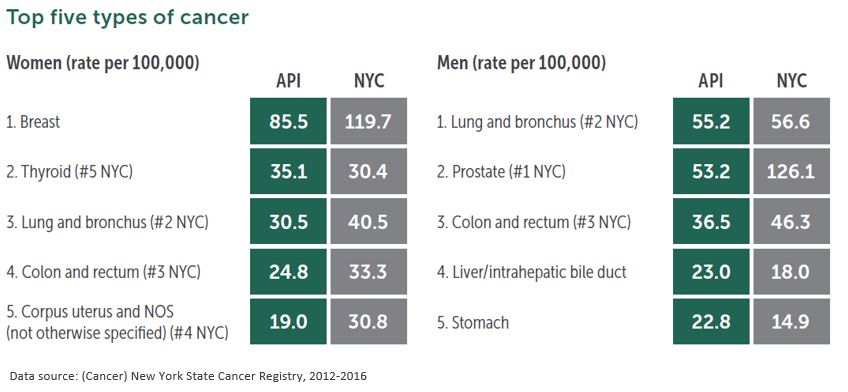
These key findings show results that would have been masked by lumping all Asians into a single group and highlights the need for more granular-level data to be collected by ethnicity, country of origin, and language group to better understand the gaps within the API community.
Helpful Resources
Health Department Releases Major Report Detailing Health of Asians and Pacific Islanders in New York City (NYC Health)
Get a monthly dose of our latest insights!

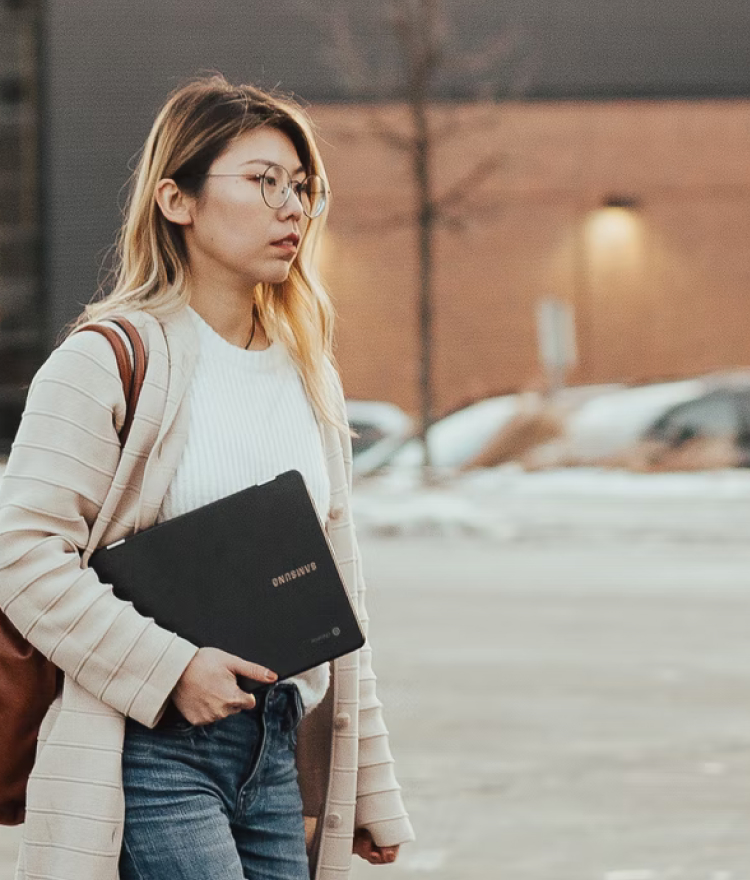
About
myasianvoice
At MyAsianVoice, we connect Asian Americans to surveys and research to bridge the Asian data gap.
Join our growing respondent list >>